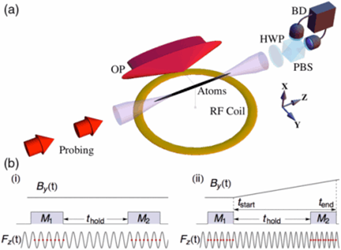Researchers Use Quantum Entanglement To Detect Radio Waves
By Jof Enriquez,
Follow me on Twitter @jofenriq

Scientists have devised a new technique that uses quantum entanglement of a million rubidium atoms to detect weak radio waves as accurately as the most sensitive radio frequency magnetometers available.
"We demonstrate a new technique for detecting the amplitude of arbitrarily chosen components of radio-frequency waveforms based on stroboscopic backaction evading measurements. We combine quantum nondemolition measurements and stroboscopic probing to detect waveform components with magnetic sensitivity beyond the standard quantum limit," wrote the study authors in Physical Review Letters.
The researchers at The Institute of Photonic Sciences (ICFO) in Barcelona, Spain, in their experiment, trapped a group of over a million cold rubidium atoms that were laser cooled to near absolute zero. When exposed to a static magnetic field, the trapped atoms are made to rotate coherently in the 42.2 kHz frequency range, or within the low frequency band used for AM radio broadcasting. Then, a weak resonant RF field is applied in an orthogonal orientation to perturb the atomic spin precession, which will generate the signal to be captured.
Typically, standard RF magnetometers, which rely on a fixed resonant frequency to trigger perturbation, will allow atomic spins to evolve freely for some time before they can detect the change in the atomic state.
According to ICFO, their scientists improve upon this older technique in two ways.
Firstly, "they use stroboscopic quantum non-demolition measurements to prepare an entangled atomic spin state at the start of the detection sequence," in order "to reduce the quantum noise coming from the atoms, and improve the sensitivity of the magnetometer beyond the standard quantum limit."
Secondly, during the free evolution period, they utilized a new method enabling them to shift the resonance frequency of the atoms to match the changing frequency of the RF field. This allowed the atoms to build up signal from a single arbitrary RF waveform, while blocking unwanted signals from orthogonal waveforms. As a result, they detected weak RF magnetic-field signals with a 25 percent reduction in experimental noise due to the quantum entanglement of the atoms.
ICREA Prof. at ICFO Morgan Mitchell, and ICFO researchers Ferran Martin Ciurana, Dr. Giorgio Colangelo, and Dr. Rob Sewell, collaborated on this new technique to entangle atoms for RF wave detection, which may be useful in a range of applications, such as bio-magnetic fields, micro-electronics, and even in the search for extraterrestrial life.
